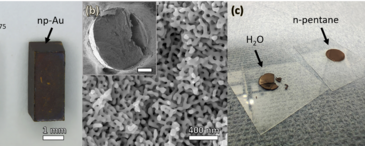Gunther Wittstock, Marcus Bäumer, Wilke Dononelli, Thorsten Klüner, Lukas Lührs, Christoph Mahr, Lyudmila V. Moskaleva, Mehtap Oezaslan, Thomas Risse, Andreas Rosenauer, Anne Staubitz, Jörg Weissmüller, and Arne Wittstock.
Chemical Reviews 123 (2023), 6716 - 6792
doi: 10.1021/acs.chemrev.2c00751
Nanoporous gold (NPG) is characterized by a bicontinuous network of nanometer-sized metallic struts and interconnected pores formed spontaneously by oxidative dissolution of the less noble element from gold alloys. The resulting material exhibits decent catalytic activity for low-temperature, aerobic total as well as partial oxidation reactions, the oxidative coupling of methanol to methyl formate being the prototypical example. This review not only provides a critical discussion of ways to tune the morphology and composition of this material and its implication for catalysis and electrocatalysis, but will also exemplarily review the current mechanistic understanding of the partial oxidation of methanol using information from quantum chemical studies, model studies on single-crystal surfaces, gas phase catalysis, aerobic liquid phase oxidation, and electrocatalysis. In this respect, a particular focus will be on mechanistic aspects not well understood, yet. Apart from the mechanistic aspects of catalysis, best practice examples with respect to material preparation and characterization will be discussed. These can improve the reproducibility of the materials property such as the catalytic activity and selectivity as well as the scope of reactions being identified as the main challenges for a broader application of NPG in target-oriented organic synthesis.
© 2023 American Chemical Society. All rights reserved.


